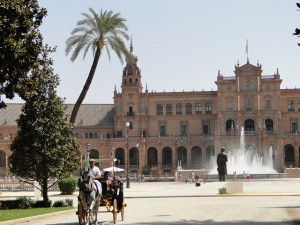Last of a 3-part series.
In our first post in this series, we began our quick guide to the 12 most popular European cruising rivers, starting with the Danube, Rhine, Seine, and the Volga and other Russian waterways — probably the best known of the top cruising rivers in Europe.
In our second post, we’ took a look at four more rivers (actually five rivers and one canal) ranging from France to Portugal, Germany and the Czech Republic to Sweden.
In this third post, we’ll complete the top 12 list with cruising rivers in Spain, Germany-Luxembourg, Italy, and, once again, France.
Spain’s Guadalquivir
A Guadalquivir cruise offers one of the most pleasant ways to explore Andalusia – Spain’s southernmost province and site of some of the country’s most fabled cities. The river itself, though one of Spain’s longest and most navigable, meanders through a quiet region of mostly undeveloped nature.
But with numerous stops and side trips to cities like Seville, Cadiz, Jerez, Cordoba and Granada – mixed with visits to nature preserves and possible bird-watching outings — Guadalquivir cruisers will experience a delightful blend of urban and rural pleasures.
Cruises typically start and end in Seville, a city blessed with remarkably diverse architecture – highlighted by the Moorish Alcázar, a onetime fort turned royal palace — and sun-kissed vegetation. Cruising west along the Guadalquivir, the cruise boats pass Donana Park, a UNESCO Natural Biosphere Reserve, and reach El Puerto de Santa Maria at the mouth of the river.
Most itineraries then divert south briefly along Cadiz Bay to visit the ancient port of Cadiz, before returning to the river and heading east back toward Seville. Along the way, you can join an excursion to Jerez, known for flamenco, sherry wine, and horses.
Back in Seville, cruisers use their boat as a base to take coach excursions to Cordoba – site of the pink-candy-striped Great Mosque, dating from the 10th century Moorish era and so huge that it dwarfs an entire Catholic cathedral located within it — and Granada, home to the splendid Alhambra, perhaps the world’s finest example of intricate Moorish architecture.
Other excursions may take you to nature preserves or olive oil-producing towns. The entire trip takes about a week. Some Guadalquivir cruises also join up with the Guadiana River on the border between Spain and Portugal, where you can discover mostly untrammeled parts of the Portuguese Algarve.
The Moselle
Lovers of wine, history and scenery can all find pleasure along the winding Moselle. The river flows into the Rhine from France and Luxembourg at the German city of Koblenz, and is usually offered as an add-on to a Rhine River cruise. A Moselle cruise presents an opportunity to visit pastoral Luxembourg, a small Grand Duchy that many European travelers overlook.
Other highlights include the German city of Trier, a UNESCO World Heritage Site that harks back to ancient Rome, with a number of monuments dating from that era, as well as Bernkastle, known for its vineyards. A Moselle cruise can add three days or so to a Rhine cruise.
The Po
Po River trips begin and end in what many consider to be the world’s most beautiful city: Venice, Italy, and then wend their way up the Po, which heads west into the interior of the country. Along the way there are chances for excursions to exquisite Italian cities like Padua, Verona, and Ferrara, which many travelers to Venice overlook.
After making your way south from Venice along the Adriatic Sea into the Po Delta, the river portion of the cruise begins at the town of Taglio di Po. From the river, Ferrara, a UNESCO World Heritage site; Verona, the setting for Romeo and Juliet; and Padua, an artistically rich pilgrimage town, require bus rides of varying lengths to reach.
Having cruised the Po and completed the excursions, the five-day voyages then head back toward the Adriatic and return to Venice for a day or two of exploration around the Venice lagoon and the city itself.
The Saône and Rhône
Like the Rhine, the Rhône rises in Switzerland, but then flows south through France before pouring into the Mediterranean Sea. The Rhône travels through Burgundy, one of France’s richest wine-producing regions, and then sunny Provence, land of lavender, artists, and a Mediterranean aura.
Most cruise itineraries start at the city of Lyon, where the Saône River meets the Rhône, but some start farther north to take in the Saône as well.
After a stay in Lyon, widely regarded as France’s gastronomic capital, a week or so on the water is typical. Castles and walled towns like Viviers, straight out of the Middle Ages; the city of Vienne, known for its Roman monuments; and wine centers such as Beaune and Tournon-sur-Rhône await.
Depending on the cruise line, you might conclude your voyage at Arles – immortalized on canvas by Van Gogh — or Avignon, with its celebrated bridge that spans the Rhône. Note that some cruises take the reverse route, starting in Avignon and finishing in Lyon or Chalon-sur-Saône to the north.
An earlier version of this post appeared on StrideTravel.com, the premier online site for organized travel around the world.















Leave a Reply